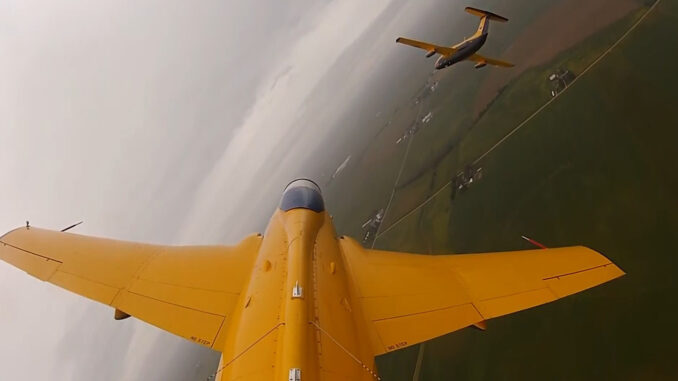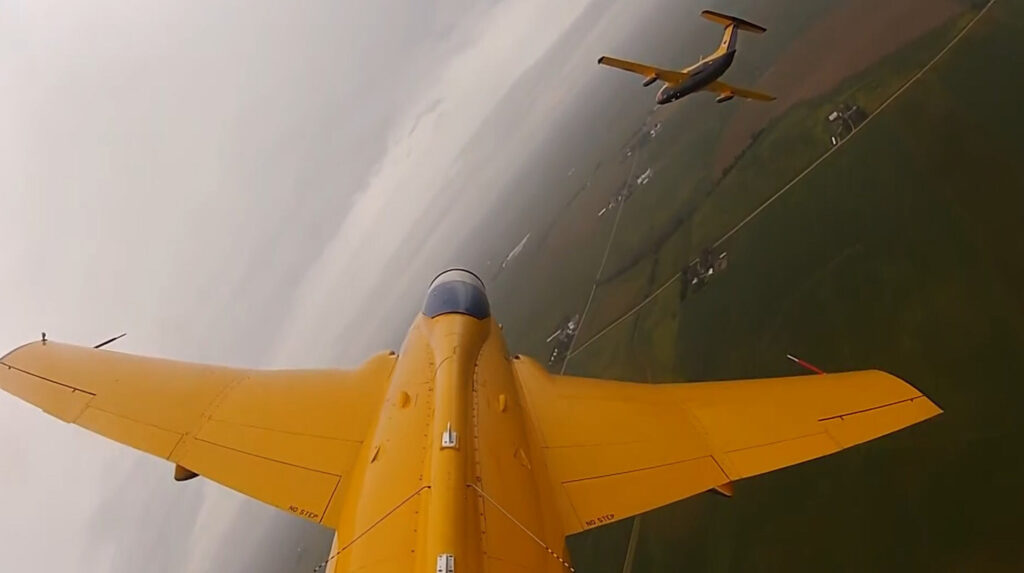
Lockheed Martin Skunk Works and the University of Iowa demonstrate the use of AI in air-to-air intercept scenarios with promising results.
In Brief
Lockheed Martin Skunk Works, in collaboration with the University of Iowa, has demonstrated the use of artificial intelligence (AI) for tactical air-to-air intercepts. The tests were carried out with an AI-piloted L-29 Delfin aircraft, testing different maneuvers against a virtual adversary. The results show that AI can execute complex maneuvers, paving the way for advanced autonomous systems for air combat missions.
Demonstration of AI in tactical air-to-air interception
Lockheed Martin Skunk Works, in partnership with the University of Iowa’s Operator Performance Laboratory (OPL), has demonstrated the use of AI in air-to-air intercept scenarios. The tests were carried out with an L-29 Delfin aircraft, piloted directly by an AI system. Maneuvers tested included heading, speed and altitude changes, executed with precision and speed. The tests aimed to assess the AI’s ability to handle complex and varied situations, ranging from standard head-on combat to encounters at different angles, as well as missile support and defeat scenarios.
Test objectives and methods
The aim of the tests was to transfer behaviors learned in simulation to real-life situations. Eight test cases were conducted per flight, covering a range of tactical scenarios. The AI had to react to a virtual opponent in both offensive and defensive postures. The results showed that the AI was able to effectively transfer the behaviors learned in simulation to real-life situations. This success demonstrated the AI’s intentionality and determination in its actions.
Expert feedback and performance
Dr. Tom “Mach” Schnell, professor at OPL, highlighted the successful integration of components on the L-29 aircraft and the superior in-flight performance compared with simulations. These flight tests are essential for improving AI capabilities and autonomy in operational contexts. Matthew “Gabe” Beard, director of autonomy/IA and machine learning engineering at Lockheed Martin Skunk Works, also highlighted the importance of these tests for the rapid and affordable development of operationally relevant AI capabilities.

Future initiatives and growing complexity
These tests are part of a broader initiative to rapidly develop and test AI-based autonomy for air-to-air missions. Lockheed Martin is planning several more flight tests this year, increasing the complexity of scenarios by introducing additional aircraft in offensive counter-air and battle management situations. AI mission performance is continuously improved in representative simulated environments, using open mission system standards to ensure broad compatibility and rapid transition to future platforms.
AI solutions from Lockheed Martin
Lockheed Martin provides AI and machine learning solutions that augment human performance by processing, fusing and analyzing vast volumes of data. These solutions deliver actionable insights and strategic advantage to their customers. The company closely adheres to US Department of Defense guidelines on the ethical and safe use of autonomous systems, ensuring that final decisions remain under human control.
Background and importance of real flight tests
Real flight tests are crucial for validating the capabilities of AI systems under authentic operational conditions. These tests help to detect and resolve problems that cannot be identified in simulation, thus ensuring the reliability and robustness of AI systems. For example, AI response to unpredictable variables such as changing weather conditions or non-standard adversary behavior can be more accurately assessed in real-life conditions.
Implications of AI advances for air combat missions
Advances in the use of AI for air combat missions have significant implications for the future of military operations. Autonomous systems can perform complex tasks with superior speed and accuracy, reducing the risk to human pilots and increasing mission effectiveness. For example, an AI system capable of simultaneously managing multiple targets and reacting in real time to emerging threats can significantly improve an air force‘s defensive and offensive capabilities.
Economic and industrial impact
The development and implementation of AI in air defense systems also has significant economic and industrial implications. The market for AI in military applications is set to grow significantly over the next few years, offering opportunities for technology and defense companies. In addition, integrating AI into existing systems can lead to cost savings by optimizing operations and reducing reliance on human resources.
Ethical and regulatory perspectives
The use of AI in military applications also raises ethical and regulatory issues. It is essential to ensure that these systems are used responsibly and in compliance with international laws. Discussions on the governance of autonomous AI systems are ongoing, and it is crucial that policymakers and ethics experts work together to establish appropriate regulatory frameworks. For example, ensuring that critical decisions remain under human control is a key principle for avoiding abuse and potential errors.
Implications for the future
Lockheed Martin Skunk Works’ successful tests on the use of AI for tactical air-to-air interception represent a significant advance in the field of military autonomy. These developments pave the way for more advanced and effective defense systems, while raising important questions about the integration of AI into military operations. The economic, ethical and operational implications of these technologies must be carefully considered to ensure that they benefit global security and stability.
War Wings Daily is an independant magazine.